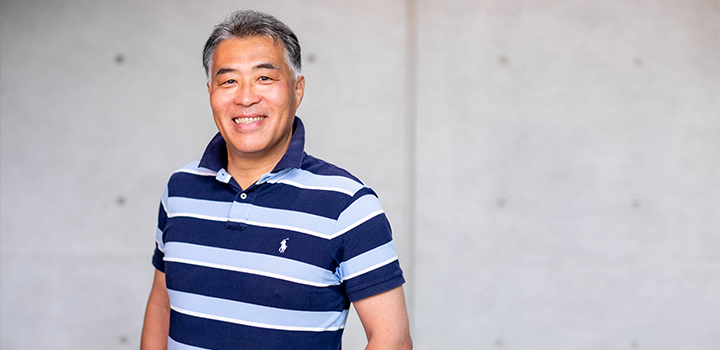Eiichi Naito

Main Lab Location:
CiNet (Main bldg.)Other Affiliations:
Invited Professor, Graduate School of Frontier Biosciences, Osaka UniversityMailing Address:
2A6 1-4 Yamadaoka, Suita City Osaka, 565-0871Email:
eiichi.naito at nict.go.jpHomepage:
https://researchmap.jp/read0045911Our laboratory primarily uses neuroimaging techniques such as MRI and behavioral approaches to research and develop technologies that allow us to gain a deep understanding of human sensory and motor functions and to improve and enhance these functions.
Our interests encompass a wide range of topics from human body perception to motor control and motor learning. For example, body image, brain representations of body awareness and self-consciousness, understanding of others, motor intention, motor imagery, motor adaptation, motor skills, and sensorimotor linkage are major research topics. In MRI research, we use brain function mapping, brain information decoding techniques, and causality analysis to understand the brain mechanisms of human sensory information processing, motor control, and motor learning from both functional and structural aspects of the brain. We are also working to understand the brain systematically through the construction of computational models based on behavioral measurements. Based on this understanding, we are developing methods to effectively improve and enhance human sensory and motor functions using methods such as robotic intervention, neural modification, and complementary sensory feedback.
Our research targets a wide range of subjects, from children to the elderly, from the visually impaired to top athletes, and visualizes functional differentiation associated with development, functional decline with aging, and brain specialization and hyper-adaptive functions observed in disabled people and sports masters to understand the plasticity at the brain network level that occurs throughout the human life span. We are trying to elucidate the rules. In particular, we are focusing on the inhibitory mechanisms that occur in the large-scale networks in the brain that allow various functions of the brain to operate in an orderly fashion, and we are also building computational models of the development and aging of these inhibitory mechanisms. Only through such multifaceted research can a comprehensive understanding of the brain be achieved. Such a comprehensive understanding of the brain will provide the academic foundation for realizing a society in which everyone, from children to the elderly and disabled, can play an active role by making the most of their own brain’s potential adaptability.
We further aim to establish a research framework in which the findings of the above basic research can be seamlessly transferred to real-life settings such as sports and rehabilitation training. To achieve this, we conduct research together with graduate students at Osaka University and are actively engaged in joint research with various universities and companies, including Osaka University.
Selected Publications:
Morita T and Naito E Facilitation of hand proprioceptive processing in paraplegic individuals with long-term wheelchair sports training. Brain Sciences 12(10), 1295, https://doi.org/10.3390/brainsci12101295, 2022.
Morita T, Hirose S, Kimura N, Takemura H, Asada M and *Naito E Hyper- adaptation in the human brain: Functional and structural changes in the foot section of the primary motor cortex in a top wheelchair racing Paralympian. Frontier in Systems Neuroscience, https://doi.org/10.3389/fnsys.2022.780652, 2022.
Naito E, Morita T, Hirose S, Kimura N, Okamoto H, Kamimukai C and Asada M Bimanual digit training improves right hand dexterity in older adults by reactivating declined ipsilateral motor-cortical inhibition. Scientific Reports 11, Article number: 22696, 2021.
Naito E, Morita T, Kimura N and Asada M Existence of interhemispheric inhibition between foot sections of human primary motor cortices: Evidence from negative blood oxygenation-level dependent signal. Brain Sciences 11, 1099. https://doi.org/10.3390/brainsci11081099, 2021.
Amemiya K, Naito E and Takemura H Age dependency and lateralization in the three branches of the human superior longitudinal fasciculus. Cortex, 139: 116-133, https://doi.org/10.1016/j.cortex.2021.02.027, 2021.
Morita T, Asada M and Naito E Examination of the development and aging of brain deactivation using a unimanual motor task. Advanced Robotics https://doi.org/10.1080/01691864.2021.1886168, 2021.
Naito E, Morita T and Asada M Importance of the primary motor cortex in development of human hand/finger dexterity. Cerebral Cortex Communications 1: 1-12, https://doi.org/10.1093/texcom/tgaa085, 2020.
Amemiya K, Morita T, Hirose S, Ikegami T, Hirashima M and Naito E Neurological and behavioral features of locomotor
imagery in the blind. Brain Imaging and Behavior 15: 656-676, DOI: 10.1007/s11682-020-00275-w, 2020.
Morita T, Asada M and Naito E Right-hemispheric dominance in self-body recognition is altered in left-handed
individuals.Neuroscience 425: 68-89 doi: 10.1016/j.neuroscience.2019.10.056, 2020.
Announcements / News:
Grant-in-Aid for Scientific Research (B):
FY 2023-2027 Functional role of intersubject inhibition in the motor cortex and validation of its trainability.
Grant-in-Aid for Challenging Research (Pioneering):
FY 2023-2026 Development of MRI-compatible hand haptic robot that opens the way for futuristic training methods.
Lab Members:
Researcher
・Tsuyoshi Ikegami
・Jihoon Park
・Gurgone Sergio
・Ozge Ozlem Saracbasi
Research Engineer
・Ryosuke Murai
Student
・Tang Yandi
・Gen Miura
・Yuki Saito
Assistant
・Noriko Karasudani
・Mayura Fujita
・Mayumi Irikawa
Collaborative Researcher
・Hideki Nakano (Kyoto Tachibana University)
・Satoshi Hirose (Otemon Gakuin University)
・Nobuaki Mizuguchi (Juntendo University)
・Hiroshi Yokoyama (Shiga University)
Invited Specialist
・Yasuharu Koike (Science Tokyo)
Staff
・Koji Takashima
